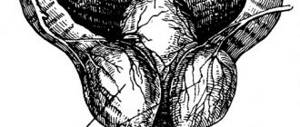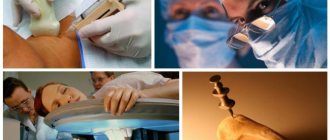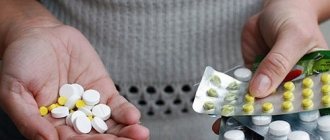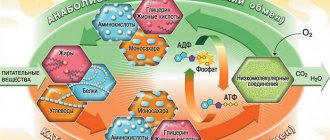One of the most important methods for diagnosing prostate diseases is a biopsy.
It allows you to obtain tissue samples for further histological and cytological studies for malignant neoplasms.
A urologist or oncologist can prescribe the procedure depending on the symptoms.
What is a prostate biopsy
This word refers to invasive medical manipulation. A prostate biopsy is performed as an outpatient procedure to diagnose prostate cancer in men. Using special equipment, fragments of pathological tissue are taken and sent for histology. Previously, a biopsy was performed by palpating the gland. Now it is performed under the control of an ultrasound machine, which reduces the risk of complications to a minimum. The biopsy result is guaranteed to be 100% accurate.
Indications
A prostate biopsy is a very accurate test, thanks to which a specialist will be able to understand whether the patient has cancer or some other disease of the prostate gland. It is prescribed in the following cases:
- During the initial palpation rectal examination of the prostate gland, the doctor detects lumps, nodes or other abnormalities.
- A blood test indicates an elevated level of prostate-specific antigen (PSA). If it is constantly large or growing, then a biopsy is repeated to clarify the diagnosis. Another indication is a decrease in free PSA relative to total PSA, which also increases the likelihood of cancer.
- While performing TRUS, the doctor discovered areas with suspiciously low echogenicity, which may indicate cancer.
- The tumor has been confirmed by other studies, but we need to find out whether it is benign (adenoma) or malignant (cancer). In the second case, the stage is immediately clarified.
A biopsy is performed in different ways. The doctor must choose which one to use, taking into account the individual characteristics of the patient. There are these types of biopsies:
- Transrectal. The equipment is inserted into the anus, while the patient takes a knee-elbow position, lies on his back with an elevated pelvis or on his side. An anesthetic is injected into the prostate area. The examination is performed with a spring needle under TRUS control. A transrectal or multifocal biopsy is done quickly. In this case, several tissue samples are taken from different parts of the organ.
- Transurethral biopsy. It is performed in the supine position under general, spinal or local anesthesia. It is performed with a cutting loop for taking material with a cystoscope - a flexible probe with illumination and a video camera. Insertion of equipment into the urethra.
- Transperineal biopsy. This access method is used less frequently than others. The patient lies on his back or side and is given general or local anesthesia. An incision is made in the perineal area, into which a biopsy needle is placed and rotated. The doctor inserts a finger into the patient's rectum to secure the prostate gland and stop bleeding after surgery. The sampling is carried out several times from different areas.
Indications for use
A prostate biopsy is necessary if:
- increasing the level of prostate specific antigen (PS) to more than 4 ng/ml;
- palpation of a lump or nodule in the prostate gland during rectal palpation;
- the presence of a tissue area with low echogenicity in the pancreas area during TRUS or transabdominal ultrasound;
- the patient's treatment through TUR - transurethral resection of the prostate or other methods (in order to assess the effectiveness of the operation).
These are indications for the primary purpose of prostate biopsy. Repeated manipulation is carried out when:
- persistently high or rising PSA levels;
- the ratio between total and free antigen does not reach 10%;
- high antigen density (more than 15%);
- detection of severe prostatic intraepithelial neoplasia during the initial biopsy;
- insufficient amount of material selected during the initial examination for histological examination.
See also: how to treat prostatitis.
How to do a prostate biopsy
The most common is the transrectal puncture approach, so it is worth talking about its stages in more detail. How is a biopsy performed:
- The doctor tells the patient how the study is performed and gives consent to it.
- The patient takes the position indicated by the doctor on the couch.
- The patient is given local anesthesia. The use of general anesthesia is not advisable.
- A TRUS sensor is inserted into the patient's rectum. It displays an image of the prostate gland on the monitor.
- Using a special device, a needle is inserted 2 cm deep. To take the required amount of material, the doctor will make many punctures into the formation itself and the tissue located near it. The patient can go home as soon as he returns to normal condition. The material in different test tubes with formaldehyde in a special container will be sent for histological examination.
- If there are any difficulties, a repeat biopsy may be performed after a few months.
Analysis results
Processing of the material takes up to two weeks. After analyzing the tissue, a specialist can make one of the following conclusions:
- benign education;
- acute inflammation (no malignant cells, glandular structures are damaged);
- chronic granulomatous inflammation;
- adenosis or atypical adenomatous hyperplasia;
- low grade prostatic intraepithelial neoplasia (PIN);
- High degree PTS;
- High-grade PIN with atypical glands (suspicion of adenocarcinoma);
- focus of atypical glands;
- a node with suspected adenocarcinoma (repeat biopsy required);
- adenocarcinoma.
To get the result, laboratory specialists use the Gleason scale. It determines the stage of adenocarcinoma and the degree of aggressiveness of malignancy. Each column of collected gland material is assessed on a five-point scale. Indicator 1 means that the aggressiveness of the tumor is minimal, 5 means maximum. The scores obtained from the analysis of the two most common changes in tissue fragments by volume are summed up. In this case, the first indicator is assigned to the tissue column in which more than half of the cells are changed, and the second to the one in which less than 50% are affected.
Characteristics of the tumor according to the Gleason index:
- 2-6. The tumor grows slowly, is well differentiated, and is not prone to early metastasis.
- 7. moderately differentiated adenocarcinoma.
- 8-10. Poorly differentiated tumor. It grows quickly and metastasizes.
Results of the procedure
After the biopsy, selected samples of the material are sent for histological and cytological examination. Results can be obtained after 7-10 days, but sometimes it may take 2 weeks to prepare them. During the study, not only tumor, but also non-tumor inflammatory processes can be detected.
If the test results confirm the presence of cancer cells, they are recorded using a five-point Gleason chart:
- 1 point: the neoplasm contains single clusters of glandular cells with unchanged nuclei;
- 2 points: the neoplasm contains a small number of glandular cells, which are separated by a special membrane from healthy tissue;
- 3 points: the tumor contains a significantly increased number of glandular cells that grow into healthy tissue;
- 4 points: the tumor is formed by modified prostate cells;
- 5 points: a large number of atypical, modified cells are detected in the tumor, proliferating into healthy tissues.
A test result of 1 point indicates the lowest aggressive prostate cancer. A score of 5 corresponds to the highest degree of cancer aggressiveness.
To assess the overall result, the scores obtained are summed up (Gleason index). This is done because different samples of selected prostatic tissue may contain completely different numbers of atypical cells. But to obtain the index, only the scores of the two largest tumors that were detected during histological and cytological examination are summed up.
The Gleason score is interpreted as follows:
- 2-4: low-aggressive and slow-growing cancer;
- 5-7: cancer has an average degree of aggressiveness and requires increased attention;
- 8-10 – fast-growing, highly aggressive cancer, prone to rapid metastasis.
A biopsy followed by cytological and histological examination is a highly accurate diagnostic procedure that makes it possible to accurately diagnose the patient. In exceptional cases, it is possible to obtain false positive or false negative results, but this happens extremely rarely.
Preparation
Before a biopsy, you need to follow certain rules. Then its quality and efficiency will be as high as possible. How to prepare for a prostate biopsy:
- A week before the test, you must stop taking medications that affect blood clotting.
- Antibiotic therapy begins 3-5 days before the biopsy. This is necessary to avoid infectious complications.
- A week before the biopsy, you should give up alcohol.
- The night before and a couple of hours before the test, you need to do a cleansing enema.
- You cannot eat on the day of the biopsy.
- You should make sure there are no contraindications and consult an anesthesiologist.
Recovery after the procedure
As a rule, upon discharge from the hospital, a sick leave certificate is issued to the patient, and the following recommendations are prescribed:
- Do not overcool;
- Do not take hot baths, do not go to saunas and steam baths, do not swim in pools and open water bodies for 1 month;
- Do not play sports and avoid physical activity for 1 month;
- Abstain from sex for 1.5 weeks;
- Follow a diet after a biopsy: do not drink caffeine-containing liquids that irritate the urethra, avoid alcohol;
- Drink plenty of fluids (up to 2.5 liters per day) for a week.
Consequences
Some complications can occur even if the prostate adenoma biopsy was performed completely correctly. Possible consequences:
- infectious-inflammatory process in the urinary tract;
- rise in body temperature;
- severe pain in the perineum and anus, discomfort;
- the presence of a small amount of blood in the urine (macrohematuria), semen, feces;
- bruises in the urethral area;
- massive bleeding (extremely rare);
- urinary retention or increased frequency;
- acute prostatitis;
- inflammation of the testicles or appendages.
Prostate biopsy price
The cost of performing the study will depend on many factors. What matters is the level of the medical institution in which the service will be provided, and its reputation, reviews, qualifications of specialists and support staff. The price is influenced by how the biopsy will be performed and how many puncture points will be made. An important factor in cost formation is the speed at which the laboratory performs analysis and provides results. Taking into account all the above points, the price of the procedure can vary from 6,000 to 70,000 rubles.
Video: how to take a prostate biopsy
Source sovets.net
Prostate biopsy is one of the options for diagnosing not only benign tumor processes, but also cancer, and this method provides the greatest amount of information regarding the tumor, which allows the subsequent use of the most effective treatment methods.
A prostate biopsy is indicated for all men without exception with palpable nodes in the gland, regardless of their size, but most patients are very scared of the study, because the word biopsy for many is tantamount to the presence of a malignant process. However, the analysis will not necessarily show carcinoma, and the prostate-specific antigen (PSA) level increases in both adenoma and prostatitis.
prostate biopsy
A morphological study, which is possible only after a biopsy, is the most accurate diagnostic method, without which a lot of other non-invasive studies are almost guessing on coffee grounds. In other words, a doctor can suspect anything, but without knowing exactly how the gland tissue is built, whether there is a malignant tumor there and what is the degree of its differentiation, he turns out to be powerless in the fight against a disease that remains unclear. The tumor continues to grow, therapy is not prescribed, and the pathology can become advanced, when even the most radical treatment becomes useless.
Many clinics to this day use outdated biopsy methods, which are quite painful for men, and therefore fear of the procedure often makes patients refuse it. However, even if it is not possible to do a biopsy in a modern way, the doctor can always offer the patient an option for pain relief, explaining the importance of the study and the likely consequences of refusing it.
If a urologist, after laboratory tests and ultrasound, strongly recommends a prostate biopsy, then it is pointless to refuse for fear of pain: a growing tumor will bring much more problems, possibly shortening life, while a short intervention, even if uncomfortable, will allow timely treatment and even completely get rid of cancer.
Indications and contraindications for the study
Pathological examination of the prostate gland is most often associated with suspicion of malignant growth. The reason for this may be:
- Detection of suspicious areas using ultrasound;
- An increase in the prostate-specific antigen (PSA) level above the age norm;
- A mass in the gland that is palpable through the rectum;
- The need to clarify the stage of the oncological process when the diagnosis was made during the removal of an adenoma or gland in connection with a benign tumor.
A repeat biopsy may be prescribed if:
- There is an increase in the PSA indicator;
- Elevated PSA does not decrease after conservative treatment of non-oncological pathology;
- PSA density over 15%;
- There is an increase in the total amount of PSA when the ratio of free protein to it falls below 10%;
- High-grade intraepithelial neoplasia was detected during the initial examination;
- The primary biopsy turned out to be uninformative due to the insufficient volume of tissue examined.
Contraindications to the study are relative, that is, the procedure will be possible after appropriate preparation of the subject. The only absolute obstacle to analysis is the man’s refusal and unwillingness to be examined. In this case, the urologist explains in as much detail as possible all the risks and what the patient may face if he neglects the biopsy.
Taking prostate parenchyma for analysis is limited when:
- Regular use of blood-thinning drugs (their discontinuation is required);
- Rectal bleeding (fissures, hemorrhoids);
- Acute or aggravated chronic proctitis;
- Acute inflammation of the gland;
- The rectum is filled with contents.
Also, the study cannot be carried out in case of severe blood coagulation disorders, decompensated pathology of internal organs, acute infectious diseases until they are completely cured, mental disorders when contact with the subject is difficult. In each case, the question of the feasibility and possibility of diagnosis is decided individually.
How to properly prepare for a prostate biopsy?
Preparation for a prostate biopsy is extremely important, because the procedure is invasive, meaning it is impossible to eliminate the risk of complications. To avoid negative consequences, the patient must strictly follow the urologist’s recommendations when preparing for the upcoming study.
Before the biopsy you need:
- Take a general blood and urine test;
- Make a coagulogram;
- Donate urine for bacteriological culture;
- Get an ultrasound of the prostate gland.
If necessary, electrocardiography, ultrasound of the abdominal organs, kidneys and other studies are prescribed in accordance with concomitant pathology. A man may be asked for the results of fluorography, tests for HIV, hepatitis, and syphilis.
If a man takes anticoagulants, they must be discontinued no later than a week before the planned biopsy. Non-steroidal anti-inflammatory drugs should be stopped three days before the procedure. If it is impossible to discontinue the drugs, the biopsy is performed in an inpatient setting. In addition, the patient must notify the doctor about all his diseases and allergies (especially to anesthetics and other medications).
In the evening before the study, it is recommended to remove hair from the perineum, take a shower, and do not have a large dinner. You should not eat in the morning, as the biopsy is performed on an empty stomach. All patients undergo a cleansing enema on the eve of the study, since intestinal contents not only make it difficult to insert instruments into the intestine, but also increase the risk of infection.
To prevent infectious complications, antibiotics of the fluoroquinolone group are used, which are taken before the study, and continue to be taken for up to a week after it.
Almost always, a prostate biopsy is an outpatient procedure, and only occasionally may hospitalization be required (in case of severe cardiovascular pathology, the impossibility of discontinuing anticoagulants).
A biopsy often involves pain relief. For this purpose, special rectal gels with lidocaine or injectable forms of anesthetics can be used, injected as the needle moves into the spaces around the gland.
How to prepare for the analysis?
It is necessary to prepare in advance for a prostate biopsy. To do this, you must follow the rules below:
- 7 days before the biopsy, it is necessary to stop taking anticoagulants, antiplatelet agents and NSAIDs that thin the blood. It is recommended to avoid the use of hormonal medications 3 days before the procedure. If it is not possible to fulfill this condition, then the study is performed only in a hospital setting.
- Before the biopsy, the patient must undergo basic laboratory and instrumental diagnostic methods. They are necessary for making a preliminary diagnosis and identifying inflammatory processes in the body. If they are detected, then first they are treated, and only then a prostatic biopsy is taken.
- In some cases, the procedure is performed under local anesthesia. In such a situation, the patient first undergoes an allergy test to determine sensitivity to a specific anesthetic drug. Typically, 2% lidocaine gel is used for this purpose, which is used to treat the rectal mucosa. Very rarely, a biopsy is performed under general intravenous anesthesia, or spinal or epidural anesthesia. Under such conditions, the patient must first undergo a consultation with an anesthesiologist.
- You should abstain from heavy foods for 24 hours before the biopsy.
- When performing a biopsy under general anesthesia, the patient must refrain from drinking liquids and eating 8-12 hours before the procedure.
- On the eve of the test, it is necessary to carry out water hygiene procedures. Particular attention should be paid to the genital area.
- If the patient is nervous before the upcoming test, the doctor may prescribe him a sedative on the eve of the procedure, before going to bed.
- The day before the test, the patient is prescribed an antibacterial drug. It must also be used for 3-5 days (sometimes longer) after the biopsy. This is necessary to prevent bacterial complications that sometimes arise during this examination.
- When performing a transurethral or transrectal biopsy, a cleansing enema is performed on the eve of the procedure.
- If anesthesia will not be used during the biopsy, then on the morning of the procedure a light breakfast is allowed.
The doctor should inform the patient at the preliminary consultation about the need for other actions related to preparation for prostate biopsy.
Types and techniques of prostate biopsy
Depending on the number of points from which the biopsy material was taken, the following are distinguished:
- Sextant biopsy - tissue is taken from six points;
- Multifocal - used most often, parenchyma sampling from 10-12 places;
- Saturation biopsy - taking tissue from at least 20 points, is indicated for those men in whom an extended study did not allow a diagnosis, while laboratory parameters and the patient’s condition indicate the presence of pathology.
Prostate biopsy is performed in different ways. So, access can be made through the rectum - then they talk about transrectal biopsy . This type of procedure is the most common.
If an endoscope with a biopsy needle is inserted through the urethra, then we are talking about a transurethral biopsy. This method is painful and has a higher risk of complications, so it is used less frequently than the transrectal method.
A blind biopsy of the prostate gland is not performed because, firstly, it is fraught with serious complications, and, secondly, modern medicine has the ability to visualize the course of the needle. The simplest and most accessible method of control is the use of ultrasound. If ultrasound control is not possible, a careful biopsy during digital examination of the rectum is allowed, but this manipulation is not so informative and is associated with great risks.
Today, surgeons use an automatic device for prostate biopsy, which makes the procedure quick and less traumatic. A special gun contains a needle that moves through the parenchyma and takes it away in a fraction of a second. Ultrasound, which complements the study, helps to clarify the shape, volume of the gland, the presence of pathological foci in it, and to conduct a targeted biopsy of the most altered fragments, but the parenchyma of the peripheral part of the organ is also necessarily taken for analysis.
Immediately before the prostate biopsy procedure, the subject changes into a clean gown, takes off his underwear, lies on his left side or back with his limbs apart, or is in a knee-elbow position. The perineal area is treated with an antiseptic and covered with a sterile napkin; the patient should not touch it with his hands, and the surgeon wears sterile gloves.
A transrectal biopsy is performed under ultrasound or finger guidance and lasts approximately half an hour. In the first case, the sensor is placed in the intestinal lumen, and before taking the tissue, the urologist injects an anesthetic in the form of a gel. A transrectal biopsy is performed with a special needle that quickly enters the tissue and comes out with a biopsy sample in less than a second. In this way, up to 12 columns of gland parenchyma are extracted. After the transrectal technique, a tampon is placed in the intestine to prevent bleeding. It is deleted the next day.
In the absence of an ultrasound sensor, the surgeon can conduct the examination under the control of his own finger placed in the rectum. The needle follows the path of the finger, rotates in the gland to puncture different points of the organ and is removed out. This method is used less frequently and is not as accurate as using ultrasound.
The transurethral type involves the position of the subject on his back and requires anesthesia, in some cases general anesthesia, since it is very painful. The surgeon inserts a special endoscope with a camera and a light source, as well as a loop for cutting tissue, into the urethra. The procedure lasts up to 45 minutes.
Transperineal biopsy is used less frequently than other surgical methods. It is indicated for narrowing of the rectum, anus, after bowel resection. The subject is placed on his side or back with his legs brought to the abdominal wall, anesthesia is carried out local or in the form of general anesthesia.
The perineal tissue is cut over a short distance, where a biopsy needle is inserted and rotated in the parenchyma of the organ while collecting material. The surgeon's finger is located in the rectum, fixing the prostate gland. At the end of the manipulation, the needle is removed and the gland is pressed to stop the bleeding. The manipulation requires approximately 30 minutes.
One of the options for prostate biopsy is fusion biopsy. Before taking the iron tissue, it is scanned with a magnetic resonance imaging scanner, as a result the doctor receives a three-dimensional image of the organ. This image is superimposed on the ultrasound image, which increases the accuracy of the biopsy and makes it as targeted as possible. In this type of operation, at least 18 fragments of the gland are taken, access is through the perineum and under general anesthesia.
Video: report on fusion prostate biopsy
Using the methods described above, both a biopsy of prostate adenoma and a study of focal changes are carried out, including in cases of previously diagnosed cancer.
The gland tissue obtained by any of the methods is placed in containers with formaldehyde and sent to the pathomorphology laboratory with a direction indicating the man’s passport details, the intended diagnosis and the features of the biopsy technique used.
Most men are afraid of pain during the examination. It can be felt at the moment the organ is pierced with a needle, but, as a rule, it is quite tolerable. Some discomfort occurs due to the presence of an ultrasound probe or the doctor’s finger in the rectum.
Patients often require a repeat biopsy, which is indicated if the result of the initial study is not reliable or there are still doubts about the tumor. It is assigned if:
- The PSA value increases by more than 0.75 ng/ml annually, regardless of the result of the initial biopsy;
- There are signs of atypia or severe dysplasia (intraepithelial neoplasia) on initial examination;
- Cancer irradiation may not be radical;
- New palpable nodes or abnormalities on ultrasound that were not previously present have appeared;
- There is a suspicion of relapse of carcinoma.
The differences between a repeat biopsy and a primary one are that tissue is taken from both peripheral and border zones; the approaches are the same in both cases. A repeat procedure can be performed 3-6 months after the initial one; it is usually accompanied by sampling of parenchyma from a larger number of points.
Consequences of prostate biopsy
After an outpatient biopsy, a man can go home within a few hours or even earlier, if there are no signs of complications, urination will be painless and without blood in the urine. In the next 4 hours, the patient should refrain from physical activity and heavy lifting; it is better not to drive. Sexual activity should be avoided for the next week.
In the next few days, slight soreness may appear in the pelvis, the urine may contain an admixture of blood, and after a transrectal biopsy, bleeding from the intestine is possible. If the biopsy was performed through the urethra, then a catheter may be left in place for several hours, and antibiotics must be prescribed.
Blood in the urine after a biopsy is one of the most common consequences of the operation. A slight admixture of it is not considered a cause for concern in the first 3 days after the study, however, heavy or prolonged bleeding or hematuria lasting more than three days is a reason to consult a doctor to exclude complications.
Prostate biopsy can cause some complications:
- Infection - especially likely with access through the intestine and the presence of undiagnosed inflammation in the gland, is prevented by antibiotics;
- Hematuria - blood in the urine due to injury to the urethra or bladder wall;
- Rectal bleeding 3 days after the date of the study;
- Allergic reaction to anesthetic;
- Pain in the perineum and rectum;
- Acute prostatitis;
- Acute urinary retention;
- Inflammation of the testicles and their appendages;
- Fainting and collapse during the study.
The most severe and dangerous consequences of a biopsy are considered to be infection with the development of sepsis. Fortunately, such a development is extremely unlikely, as are other negative consequences, so a prostate biopsy is considered a safe test.
You should contact your doctor immediately if you have fever, severe pain in the abdomen or pelvis, inability to empty your bladder for more than 8 hours, or severe bleeding.
Complications
Prostate biopsy is considered a relatively safe procedure. But in some cases it can lead to the development of complications:
- hematuria (appearance of blood in the urine) – in 35% of cases;
- pain in the perineum and/or anus – in 30% of patients;
- hemospermia (the appearance of blood in the seminal fluid) – in 27% of patients;
- acute prostatitis – in 3.5% of cases;
- bleeding from the rectum - in 2% of cases;
- acute urinary retention – in 1.5% of patients;
- acute orchiepididymitis – in 1.1% of patients.
1.1% of patients experience syncope (loss of consciousness) during the diagnostic procedure.
An extremely rare, but quite dangerous complication of prostate biopsy is the development of septic shock. But, in general, this diagnosis goes well, so it can be carried out on an outpatient basis.
Evaluation of biopsy results
The results of a prostate biopsy can be obtained 7-10 days after surgery. They should be analyzed by a specialist who will explain to the patient the essence of the identified pathology and tell about further actions. Due to the complexity of interpreting the conclusions of pathologists, you should not try to diagnose yourself in order to avoid erroneous unprofessional judgments and unfounded fears.
The results may indicate the presence of prostatitis, which, like a tumor, provokes an increase in PSA, but does not pose a threat to life. Benign tumor-like processes—hyperplasia, as well as adenomas—are not uncommon. About a third of patients with elevated PSA levels are diagnosed with cancer through a biopsy.
A biopsy of prostate adenoma is performed due to increasing PSA levels. It is likely that the conclusion will be limited to a true benign tumor - an adenoma, or diffuse hyperplasia of the gland, which often occurs in elderly men. However, a detailed histological examination allows both to detect areas of microcarcinoma that are inaccessible to non-invasive diagnostics and to exclude the possibility of a tumor.
Prostate cancer is most often represented by glandular carcinoma of low to high differentiation. Early diagnosis gives a chance to see a tumor limited to an organ, which significantly improves the prognosis and increases the survival rate of patients.
To assess the histological picture in the prostate, the Gleason scale is used, which is recognized throughout the world as the most diagnostically valuable. To do this, in biopsy samples, the two most characteristic zones in structure for a given formation are selected and scores are determined for them based on the degree of differentiation, structural features of the glands, and cellular atypia.
Points 1-2 correspond to a tumor that does not extend beyond the prostate and is surrounded by a kind of capsule of healthy tissue. Starting from 3 points and up to 5, carcinomas have invasive growth, growing into healthy surrounding tissues and extending beyond the organ. By summing up the points, we get a Gleason score from 2 to 10. The higher it is, the more malignant the carcinoma and the lower the degree of its differentiation.
By calculating the result on the specified scale, the morphologist gives the urologist not only a total assessment of the tumor, but also indicates what this sum is made up of. For example, a total score of 4 can correspond to both a tumor that has not grown into healthy tissue (2+2) and a carcinoma that has begun active invasion (1+3). This is important for assessing the behavior of the tumor in the future.
The result of a prostate biopsy according to the Gleason score allows the oncologist to draw conclusions about the prognosis of the disease, as well as select treatment regimens that are more effective for this type of cancer. It is important to note that the absence of tumor cells in biopsies does not exclude the possibility of cancer, so many patients continue to be systematically examined.
Prostate biopsy results: interpretation and highlights
The doctor will receive the results of the biopsy a few days after the procedure. The time required to decipher and interpret results may vary depending on the complexity of the analysis, the need to consult with another specialist, and other factors.
Positive prostate biopsy results mean that cancerous cells have been found.
The lab will grade the cells according to the Gleason score, which helps predict how quickly the cancer will grow.
A biopsy may also show cells that look abnormal but do not necessarily indicate cancer. In this case, a repeat biopsy may be required.
Video: report on prostate biopsy
Source operaciya.info
One of the most reliable and complete research methods that can be used to determine the presence or absence of various diseases or disorders of the prostate is a prostate biopsy. Such a study involves taking a small piece of soft tissue, which will be studied by specialists in a laboratory setting. In most cases, a prostate biopsy is performed if there is a suspicion of a tumor in the male genital area, especially if it is suspected of being malignant.
Where can I undergo the procedure, what is its cost and patient reviews?
In order for a prostate biopsy to give accurate results, when prescribing it, you should think about where it is best to undergo this diagnostic test. Currently, many medical institutions offer services for its implementation, but it is best to choose a private or public oncology center (clinic). Only in these specialized institutions can you get a transcript of the diagnostic results and consultation with an experienced specialist on further dynamic observation or treatment of the detected disease.
The price for a biopsy procedure of the main organ of the male reproductive system, responsible for male strength, ranges from 1000 rubles. The final cost of a diagnostic study is directly dependent on the clinic where it will be carried out, and the type of manipulation for collecting affected tissue and depends on the following pricing factors:
- cost of a day in the clinic (food, care);
- prices for reagents for histological examination;
- final consultation with a specialist (at state oncology centers it can be obtained free of charge, if you have a compulsory medical insurance policy).
Reviews from patients who have undergone a prostate biopsy indicate that this procedure, which makes it possible to make a correct diagnosis, is almost completely painless and, if you follow all the specialist’s recommendations, does not cause complications.
Indications and contraindications for prostate biopsy
A prostate biopsy should be performed if the doctor palpates a tumor in the prostate area. A biopsy is also prescribed if, during an ultrasound, doubts arise about the structure of the prostate gland and its parts, as well as if there is a noticeable increase in the level of prostate-specific antigen, which was detected in the tests. If you experience symptoms such as urinary incontinence, discomfort during urination, pain in the pelvic area or lower back, you should consult a doctor as soon as possible.
However, there are some contraindications to performing a biopsy. For example, the study should never be carried out in the presence of an inflammatory process in the rectum or hemorrhoids, the presence of an infectious disease in a man, low blood clotting and exacerbation of prostatitis.
In some cases, you first need to undergo treatment, and only then can you take a piece of tissue for analysis. Sometimes you have to wait a little longer before doing a prostate biopsy. The exact method in which the research will be conducted will also depend on the man’s health status.
Contraindications for biopsy
The described method may not be suitable for all men. For example, in insulin-dependent diabetes mellitus, doctors are extremely reluctant to refer for a biopsy due to the high risk of complications. In addition to this disease, the following may be contraindications:
- blood clotting pathologies;
- acute prostatitis or chronic in the acute stage;
- hemorrhoids in acute form;
- any infectious disease;
- renal, cardiac or transport failure.
Also, some surgical interventions performed shortly before visiting a doctor may be a contraindication to a biopsy.
Might be interesting:
|
Types of prostate biopsy
There are several ways to perform a prostate biopsy: transrectal method, transurethral biopsy and transperineal. The choice of a specific method depends on the individual characteristics of the man and his health conditions.
The transrectal method can be performed in several positions, namely: knee-elbow position, on the side with knees tucked, or on the back with legs on supports. Before the procedure, the urologist will inject an anesthetic into the areas around the prostate. This method must be carried out under the strict supervision of transrectal ultrasound so that the needle hits the gland or desired area exactly. As a rule, everything is done with a spring needle, which very quickly enters the prostate, collects a piece of tissue and quickly exits. All this happens within one second. In this way, up to 10 pieces of prostate tissue are taken from different areas. The doctor’s finger, which feels the prostate gland when inserting a needle through the wall of the rectum, can also serve as a guide for this method. The needle is rotated in the thickness of the gland, then makes a fence and is removed. A transrectal biopsy usually takes about half an hour.
During the transurethral method of biopsy of prostate adenoma, the patient should be in a supine position, with his legs extended on special supports. The biopsy is performed using general, local or spinal anesthesia. In this case, a special cystoscope is used, which is a flexible thin probe with a light bulb and a video camera lens. A cutting loop is also used, that is, a device for taking a biopsy sample. Transurethral biopsy is performed over 30-45 minutes.
Transperineal biopsy is performed quite rarely. In this case, the patient is on his back or side with his knees tucked under general or local anesthesia. First, a small incision is made in the perineal area, then a thin biopsy needle is inserted into it, which carefully rotates through the thickness of the tissue and takes its pieces. In this case, the doctor's finger must be inserted into the rectum to fix the prostate. Tissue must be taken from several areas of the prostate, after which the needle can be removed. The prostate may be pressed to stop bleeding. This biopsy takes approximately 15-30 minutes.
Preparing and performing a biopsy
This diagnostic technique has a number of features, so it is necessary to properly prepare before performing it.
A prostate biopsy is performed only after the following preparatory measures, which the attending physician recommends to each patient undergoing this procedure:
- in the 7 days preceding the procedure, it is necessary to undergo a preventive course of antibacterial therapy to reduce the risk of complications;
- inform the specialist who will carry out the diagnosis about the presence of allergic reactions and medications used in recent days;
- when prescribing a transrectal biopsy, immediately before the procedure, clean the rectum with an enema;
- For three days it is necessary to give up alcoholic beverages, fatty, spicy and smoked foods.
Before carrying out a diagnostic procedure, the patient must be given a contract to sign, in which he confirms his consent to the collection of tissue from the prostate through a biopsy. Most often, diagnostic manipulations are performed transrectally.
His technique consists of the following sequential actions:
- the patient undresses and lies down on the couch on his right side, with his legs pulled up to his stomach;
- the anus is treated with an anesthetic gel;
- A special needle is inserted into the anus and 6 consecutive punctures are performed, taking away a small amount of altered tissue with each one.
When performing this type of diagnostic study, the use of ultrasound equipment is very often practiced, which allows you to most accurately select the location for the puncture.
Ultrasound-guided prostate biopsy












